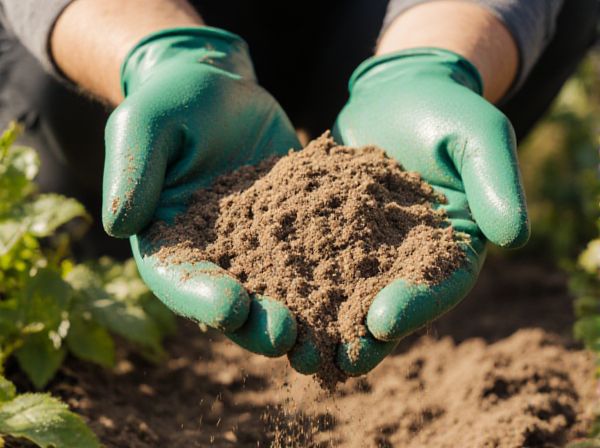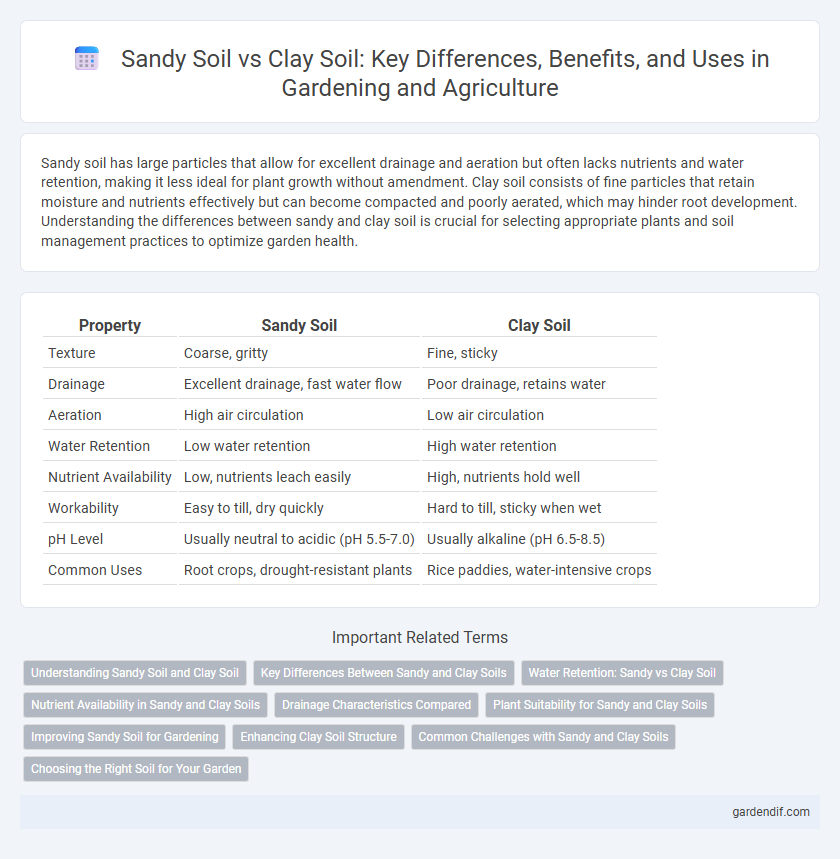
Sandy soil vs Clay soil Illustration
Sandy soil has large particles that allow for excellent drainage and aeration but often lacks nutrients and water retention, making it less ideal for plant growth without amendment. Clay soil consists of fine particles that retain moisture and nutrients effectively but can become compacted and poorly aerated, which may hinder root development. Understanding the differences between sandy and clay soil is crucial for selecting appropriate plants and soil management practices to optimize garden health.
Table of Comparison
| Property | Sandy Soil | Clay Soil |
|---|---|---|
| Texture | Coarse, gritty | Fine, sticky |
| Drainage | Excellent drainage, fast water flow | Poor drainage, retains water |
| Aeration | High air circulation | Low air circulation |
| Water Retention | Low water retention | High water retention |
| Nutrient Availability | Low, nutrients leach easily | High, nutrients hold well |
| Workability | Easy to till, dry quickly | Hard to till, sticky when wet |
| pH Level | Usually neutral to acidic (pH 5.5-7.0) | Usually alkaline (pH 6.5-8.5) |
| Common Uses | Root crops, drought-resistant plants | Rice paddies, water-intensive crops |
Understanding Sandy Soil and Clay Soil
Sandy soil consists of large particles that provide excellent drainage but poor nutrient retention, making it ideal for plants requiring well-aerated conditions. Clay soil has very fine particles that retain water and nutrients efficiently but often suffer from poor drainage and aeration, which can lead to root rot. Understanding the texture and composition of sandy and clay soils helps optimize agricultural practices and improve plant growth outcomes.
Key Differences Between Sandy and Clay Soils
Sandy soil features large particles that provide excellent drainage but poor nutrient retention, while clay soil consists of fine particles that retain water and nutrients effectively yet drain slowly. Sandy soil is typically light, loose, and warms up quickly in spring, whereas clay soil is dense, heavy, and prone to compaction. Understanding these differences is crucial for selecting suitable crops and managing irrigation practices in agriculture and gardening.
Water Retention: Sandy vs Clay Soil
Sandy soil has large particles and pores, causing it to drain quickly and retain less water, which can lead to rapid drying and nutrient leaching. In contrast, clay soil contains tiny particles that hold water tightly, resulting in high water retention but poor drainage and potential waterlogging. Understanding these water retention differences is crucial for optimizing irrigation practices and plant health in different soil types.
Nutrient Availability in Sandy and Clay Soils
Sandy soil typically has low nutrient availability due to its coarse texture and poor water retention, which leads to faster leaching of essential minerals such as nitrogen, potassium, and phosphorus. Clay soil, with its fine particles and high cation exchange capacity, retains nutrients more effectively, making essential nutrients more accessible to plants over time. However, clay soil's dense structure can hinder root penetration and reduce oxygen availability, potentially affecting nutrient uptake despite higher nutrient content.
Drainage Characteristics Compared
Sandy soil exhibits excellent drainage due to large particle size and high porosity, allowing water to pass through quickly and minimizing water retention. Clay soil has very poor drainage properties because of its fine particles and dense structure, leading to slow water movement and high water retention, often causing waterlogging. Understanding these drainage characteristics is essential for crop selection and irrigation management to prevent root diseases and optimize soil moisture.
Plant Suitability for Sandy and Clay Soils
Sandy soil, characterized by large particles and excellent drainage, is ideal for drought-tolerant plants such as cacti, succulents, and root vegetables like carrots and potatoes that require quick water absorption and minimal water retention. Clay soil, with its fine particles and high nutrient content, supports water-loving plants like rice, iris, and certain shrubs that thrive in moisture-retentive, fertile conditions but require good drainage management. Gardeners must match plant species with soil texture to optimize growth, yield, and root health, leveraging sandy soil for aeration and clay soil for nutrient retention.
Improving Sandy Soil for Gardening
Sandy soil, characterized by large particles and excellent drainage, often suffers from poor nutrient retention and low water-holding capacity, making it challenging for gardening. Improving sandy soil involves incorporating organic matter such as compost, peat moss, or well-rotted manure to enhance moisture retention and nutrient availability. Mulching and applying slow-release fertilizers further support plant growth by maintaining soil structure and providing a steady supply of nutrients.
Enhancing Clay Soil Structure
Enhancing clay soil structure involves incorporating organic matter such as compost or aged manure to improve aeration and drainage. Gypsum application helps to break up compacted clay particles, reducing soil crusting and promoting root penetration. Regularly practicing crop rotation and cover cropping also supports soil aggregation, increasing microbial activity and nutrient availability in clay soils.
Common Challenges with Sandy and Clay Soils
Sandy soil often struggles with poor water retention and nutrient leaching, which limits plant growth and requires frequent irrigation and fertilization. Clay soil, conversely, faces challenges such as poor drainage, compaction, and slow aeration, leading to waterlogging and root suffocation. Both soil types demand tailored management practices to improve fertility, structure, and water availability for optimal crop health.
Choosing the Right Soil for Your Garden
Sandy soil offers excellent drainage and warms quickly in spring, making it ideal for plants that require well-aerated, fast-draining conditions, but it often lacks nutrients and retains little moisture. Clay soil, rich in nutrients and moisture-retentive, supports plants that thrive in steady water availability but may cause root rot or compaction in poorly drained gardens. Selecting the right soil involves assessing your plant species' water and nutrient needs alongside your garden's drainage capabilities to optimize growth and prevent common soil-related issues.
Sandy soil vs Clay soil Infographic

 gardendif.com
gardendif.com